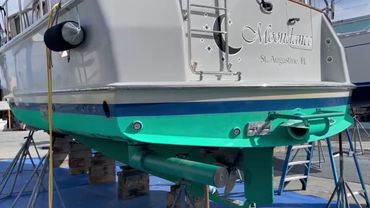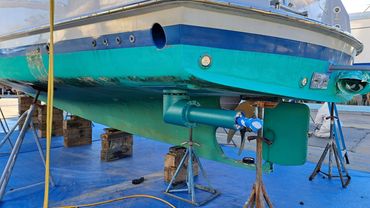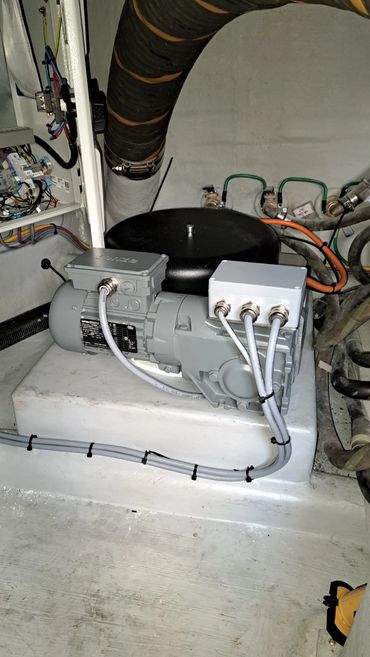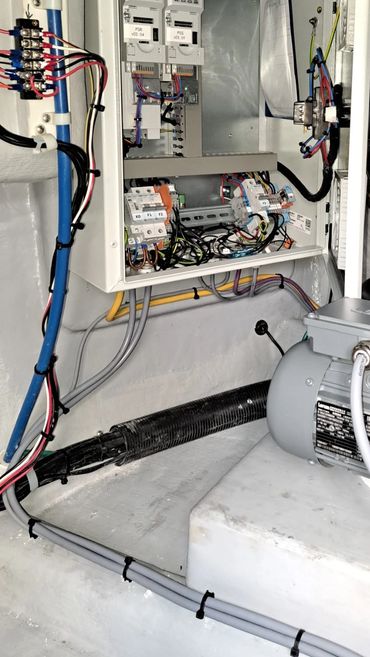Magneto
Veteran Member
- Joined
- Dec 24, 2019
- Messages
- 65
- Location
- United States
- Vessel Name
- MV Moondance
- Vessel Make
- Nordhavn 35#20
We are very excited to share our story of being the first Nordhavn 35 to install a stabilizer system.
Not just your typical gyro or fins, but something unique. It’s called a Magnus Master and uses a one-meter rod that spins in two directions under water.
The rod is around 6 inches in diameter and spins up to 1000 RPM both forward and reverse pushing and pulling the water over the surface of the rod causing lift. Enough lift power to dampen or stabilize four-foot waves on the beam.
The boat needs to be moving over 5 knots and our cruising speed is around 8.5 knots which makes trawlers ideal for this application. It does not work at anchor. It performs great while cruising the ocean or ICW.
 I love the fact you can deploy and park it in 13 seconds. On the ICW, I keep it parked to avoid crab traps but as soon as a fast deep V-hull starts to pass me, (without notifying his intent on the radio), I have maybe 15-20 seconds before a 3-foot wave rocks our boat and threatens to spill my beer. I now press a button and am instantly gratified by a calmer passing.
I love the fact you can deploy and park it in 13 seconds. On the ICW, I keep it parked to avoid crab traps but as soon as a fast deep V-hull starts to pass me, (without notifying his intent on the radio), I have maybe 15-20 seconds before a 3-foot wave rocks our boat and threatens to spill my beer. I now press a button and am instantly gratified by a calmer passing.
In the ocean, so far, we have been out in 3-foot waves on the beam with some following seas. I have no experience with gyro systems so I can’t compare but we are very satisfied with the performance of this DMS system. We can now take the outside in bigger wave conditions than we’ve been able to do without a stabilizer.
The largest selling point to me was the size. Nordhavn 35 has little room for the typical fins or gyro. But it does have a decent storage area in the lazarette and the DMS system will work anywhere placed on the beam under the water line.
I’ve attached some pictures but you can view more details on our website; MVmoondance.com or see the complete installation video on our YouTube channel. I’ll post links below. If you want the technical details, visit dmsholland.com and view the Magnus Master stabilizer.
Also the links to our YouTube channel is:
https://www.youtube.com/@mvmoondance1283
The installation video is at:
https://www.youtube.com/@mvmoondance1283
John & Carol
Moondance N35#20
St Augustine FL.
MV Moondance




Not just your typical gyro or fins, but something unique. It’s called a Magnus Master and uses a one-meter rod that spins in two directions under water.
The rod is around 6 inches in diameter and spins up to 1000 RPM both forward and reverse pushing and pulling the water over the surface of the rod causing lift. Enough lift power to dampen or stabilize four-foot waves on the beam.
The boat needs to be moving over 5 knots and our cruising speed is around 8.5 knots which makes trawlers ideal for this application. It does not work at anchor. It performs great while cruising the ocean or ICW.

In the ocean, so far, we have been out in 3-foot waves on the beam with some following seas. I have no experience with gyro systems so I can’t compare but we are very satisfied with the performance of this DMS system. We can now take the outside in bigger wave conditions than we’ve been able to do without a stabilizer.
The largest selling point to me was the size. Nordhavn 35 has little room for the typical fins or gyro. But it does have a decent storage area in the lazarette and the DMS system will work anywhere placed on the beam under the water line.
I’ve attached some pictures but you can view more details on our website; MVmoondance.com or see the complete installation video on our YouTube channel. I’ll post links below. If you want the technical details, visit dmsholland.com and view the Magnus Master stabilizer.
Also the links to our YouTube channel is:
https://www.youtube.com/@mvmoondance1283
The installation video is at:
https://www.youtube.com/@mvmoondance1283
John & Carol
Moondance N35#20
St Augustine FL.
MV Moondance




